Helsingør,Denmark 作者: 来源: 发布时间:2021-06-18
一、人口,面积,所属地区
Population: 62,695
Area: 122 km²
Municipality in Hovedstaden
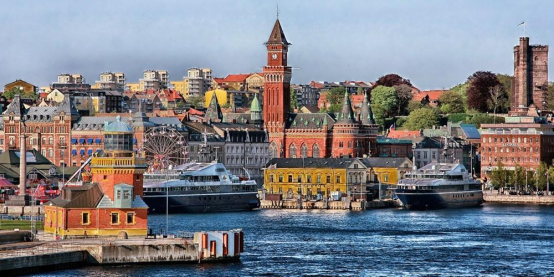
二、自然地理(或者地理环境、自然资源、交通情况)
Helsingør Municipality is a municipality in the Capital Region on the northeast coast of the island of Zealand (Sjælland) in eastern Denmark.
The main town and the site of its municipal council is the town of Helsingør. Other towns include Ålsgårde, Espergærde, Hellebæk, Hornbæk, Kvistgård, Snekkersten, and Stenstrup. To the east is the Øresund, the strait which separates Zealand from Sweden. To the north is the Kattegat.
Helsingør is the largest city and main shopping destination in North Zealand, with over a million visitors a year. It is known for its castle Kronborg, where William Shakespeare's play Hamlet is set.
Transport
Ferry service connects the municipality at the town of Helsingør east over the Øresund to the town of Helsingborg, Sweden. The European routes E47 and E55 traverse the two cities.
The car ferry line between Helsingør and Helsingborg, Scania, Sweden is the busiest in the world with more than 70 departures in each direction every day. The route is known as the HH Ferry route and has been sailed by several shipping lines through history. The car ferry terminal is connected to the town's main railway station. From the station, trains depart to Copenhagen every 20 minutes. Trains also depart to Hillerød and Gilleleje. There are another 6 stations or train stops within the city and connected suburbs. Apart from Helsingør Station and Ferry Terminal also Snekkersten station, Espergærde station, Mordrup station and the train stops at the line to Gilleleje, Grønnehave, Marienlyst and Højstrup The E47 Motorway towards Copenhagen begins just outside the city limits. The town and surrounding areas also has a network of local and regional buses.
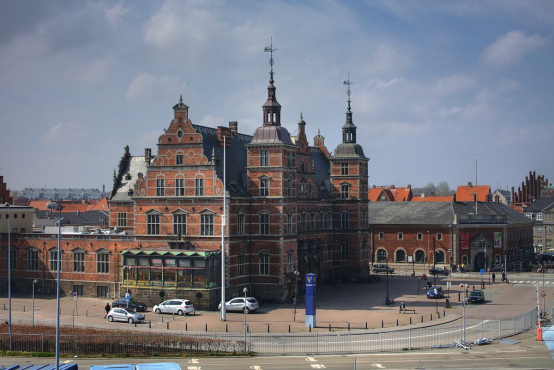
三、经济发展和规模
The municipality had budgeted with a deficit of DKK 16.5 million. DKK 201 in budget 2019. The municipality instead went out with a total deficit of DKK 32.2 million DKK, an additional consumption of DKK 16.7 million. kr. relationship to originally budgeted.
Personal taxes
Income tax rate: 25.3% for 2019
Tax rate: 0.63%
property Taxes
Basic debt profile: 28.5 ‰
Basic debt profile on production land: 7.2 ‰
Coverage of the difference in value for commercial properties: 6.80 ‰
Coverage of the difference in value of public property: 8.75 ‰
Coverage tax on governmental and other public basic values: 14.25 ‰
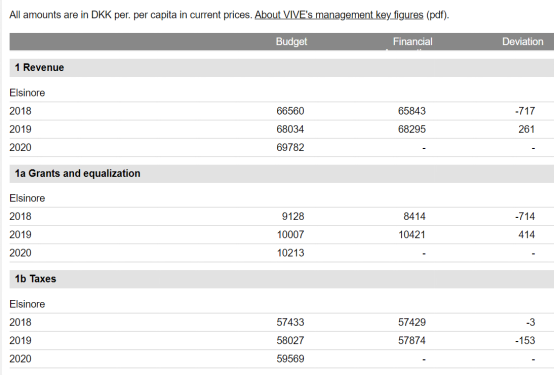
*All amounts are in DKK per. per capita in current prices.
四、产业特点/重点项目
For a century, a notable site was the Helsingør Værft or Elsinore shipyard, which covered the whole area between the town and Kronborg Castle. It was founded in 1882. At its height in 1957, it had 3,600 employees. The last ship left the shipyard in 1983 and it closed the same year following heavy losses.
The Wiibroe brewery, founded in 1840, was the second brewery in Denmark to ship bottled beer, just three years after Carlsberg. The last beer was brewed at Wiibroe in Helsingør in 1998. Carlsberg continues to brew beer under the Wiibroe Årgangsøl label.
After the end of the industrial era, the town of Helsingør had to redefine itself, and came up with an ambitious project: Kulturhavn Kronborg, literally "Culture-harbour of Kronborg". It officially opened on 26 May 2013, intended to appeal to tourists with an interest in culture. The main attraction of Kulturhavn Kronborg is Kronborg Castle, a UNESCO World Heritage Site. Besides the historical attractions of the site, William Shakespeare's play Hamlet is performed annually in its courtyard since 1937. There is a longstanding tradition of performing the play in English, and notable actors in the title role have included Laurence Olivier, John Gielgud, Christopher Plummer, Derek Jacobi, and in 2009 Jude Law. At the heart of Kulturhavn Kronborg lies kulturværftet or The Culture Yard, a new cultural centre and a public library located in the old dockyard. It opened in 2010. The former dry dock now houses the Danish Maritime Museum.
Identify and develop strengths within:
Textile industry
Plastic industry
The transport and logistics industry
Culture and tourism industry
Maritime professions
The health area
both in relation to public and private players
Strengthen and develop the cooperation between Helsingør, Gilleleje and Hundested Havnearound a maritime cluster. The development must balance the interests of the recreationand the business-oriented part of the Port of Helsingør.
Develop cooperation with the Port of Helsingborg in relation to the service port of Helsingør.
Develop the local and regional business community together with the Municipality of Helsingborg.
五、风景名胜,景点
Helsingør North Harbor
Address: Nordhavnsvej 13, 3000 Helsingør
Helsingør Nordhavn (North Harbour) is a municipal yachting harbour with about 1000 berths. It was built as a fishing port and yachting harbour by the municipality of Helsingør in the years 1932-1934 and was in the beginning of the 1970 extended to its present size.
Nordhavnen has an authentic atmosphere where citizens as well as tourists feel at ease beause of the right mixture of recreation, leisure and still ongoing business.
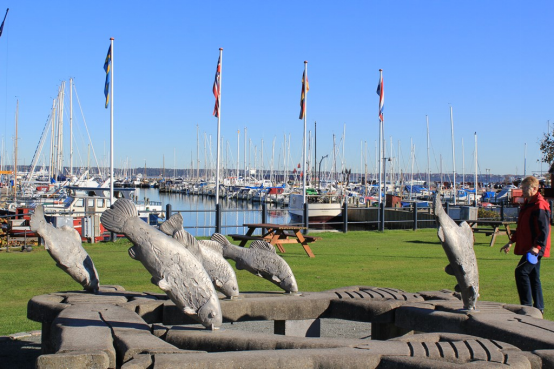
Helsingør Cathedral Skt. Olai
Address: Sct. Annagade 12, 3000 Helsingør
The construction of the church finished in 1559.
The oldest part from 1200. Furnishings mainly from the 17th century.
Baptismal font from 1579. Wood carvings from the 17th century.
The church was thoroughly restored in the period 2000-2001.
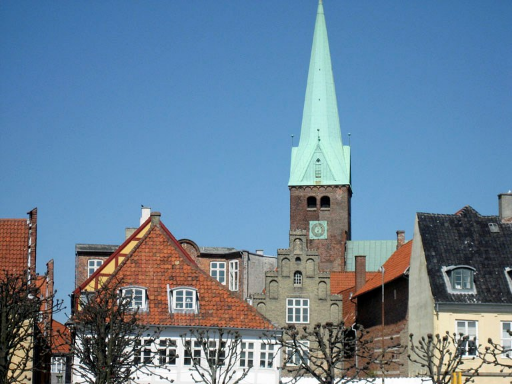
六、历史文化
The town as we know it today was founded in the 1420s by the Danish king Eric of Pomerania. He established the Sound Dues in 1429 and built the castle 'Krogen', which was made bigger in the 1580s and named Kronborg. Kronborg Castle, known internationally as the setting of William Shakespeare's theatre play Hamlet, is today the town's main tourist attraction.
The oldest known fortified building of Helsingør is Flynderborg, an early medieval fortress situated on a hill just south of the medieval city. Around 1200, the first church, Saint Olaf's Church, was built. A number of convents once surrounded the church, but now all that remains is the church building, today the cathedral of the Diocese of Helsingør. The oldest parts of the cathedral of Helsingør date back to the 13th century and tell us that the fishermen's village, as Helsingør was then, had grown to a town of importance.
The name Helsingør is derived from the word hals meaning "neck" or "narrow strait", referring to the narrowest point of the Øresund (Øre Sound) between what is now Helsingør and Helsingborg, Sweden. The people were mentioned as Helsinger (which may mean "the people of the strait") for the first time in King Valdemar the Victorious's Liber Census Daniæ from 1231 (not to be confused with the Helsings of Hälsingland in Sweden). Placenames show that the Helsinger may have had their main fort at Helsingborg and a fortified landing place at Helsingør, to control the ferry route across the strait.
Helsingør as it is known today was founded in the 1420s by the Danish king Eric of Pomerania. He established the Sound Dues in 1429, meaning all foreign ships passing through the strait had to pay a toll, which constituted up to two-thirds of Denmark's state income. With this income Eric of Pomerania built the castle Krogen. The castle was expanded in the 1580s and renamed Kronborg. All ships had to stop in Helsingør to get their cargo taxed and pay a toll to the Danish Crown, but it also generated a significant trade for the town. In 1672 Helsingør had grown into the third biggest town in Denmark. Johan Isaksson Pontanus (Rerum Danicarum Historica, 1631) attributes a long and partially fictitious history to Helsingør.
The Sound Dues were abolished in 1857 with the Copenhagen Convention, where all naval nations agreed to pay a one-time fee.
In the centre of the harbour basin stands the polished steel sculpture "Han" ("He") by artist duo Elmgreen and Dragset, commissioned by the City of Helsingør in 2012. It was inaugurated by then Minister of culture, Uffe Elbæk, in June, 2012. It is seen as the counterpart (and even little brother) to Edvard Eriksen's world famous The Little Mermaid statue in Copenhagen, and has caused both praise and protests among locals.
Helsingør municipality was not merged with other municipalities due to the nationwide Kommunalreformen ("The Municipality Reform" of 2007).
七、其他信息
Helsingør as a free municipality
On October 10, 2016, the then Ministry of Social Affairs and the Interior selected Helsingør Municipality as a free municipality together with eight other municipalities under the heading: “A plan for a coherent effort”.
This means that the municipality of Helsingør can be exempted from sections and process requirements in selected areas during the free-municipality period, which runs until 31 July 2020. Existing experiments may be possible. be allowed to continue for a little longer than July 31, 2020, which is why the longer statute has been stated so far.
Helsingør Municipality is part of a free municipal network together with eight other municipalities: Ballerup, Allerød, Fredensborg, Frederikssund, Furesø, Gribskov, Halsnæs and Hillerød Municipality.
The municipalities have initiated various efforts to provide new knowledge and experience on how state rules and procedures can be simplified, so that citizens can have a smoother and better coordinated case management.
In Helsingør Municipality, the status of a free municipality is used to work more closely across professional centers to offer citizens with complex case plans a single action plan instead of a series of individual action plans, and to provide the citizen with few contacts and a comprehensive case management based on the individual's resources and challenges. The aim of the experiments is to promote the citizens' opportunities to get an education, enter the labor market and / or increase the well-being of the citizens.
The action plan is drawn up in close cooperation with the individual citizen. It is optional for each citizen if he or she wishes to accept the offer of one coherent plan.
Experiences with workflows are continually shared across municipalities and are ultimately evaluated by the National Research and Analysis Center.
The exemption options used in the Municipality of Helsingør are described in more detail in the free municipal statutes. It is important to emphasize that information obtained from the interconnection of data in connection with the free municipal effort must never be used without the consent of the citizen.
Elsinore - the old part of town
Helsingør/Elsinore has one of Europe's best preserved historical town centers, thanks to far-sighted conservation people in the municipality in the 1960s and 70s. In few other cities so many beautifully restored houses can be seen, in architectural styles ranging from the 15thcentury up to present time.
When the Sound Due (1427–1857) was introduced by King Erik of Pomerania, Helsingør rapidly developed from a small fishing hamlet to a regular market town with solid brick houses and a magnificent castle. For more than 400 years Helsingør was an international town – even Shakespeare heard about it!
Most likely, King Erik back in the 14thcentury was responsible for the town-plan which still can be seen today in the old part of Helsingør. A perfect grid consisting of 3 streets parallel to the coastline and 4 streets placed at right angles onto them. Only the cathedral Sct. Olai doesn’t fit in – because it origins from the 12th century.
The history of Helsingør is comprehensive and colourful .It is a great experience to take a guided city-walk. In the summer half-year the town museum arranges city-walks for individuals and all year round VisitNordsjaelland arranges pre-booked guided tours for groups.
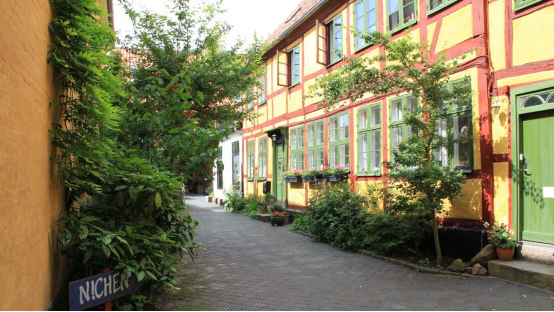
八、联系方式
Mayor: Benedikte Kiær
Address: Stengade 59, 3000 Helsingør
Telephone: 49 28 28 28
mail: mail@helsingor.dk
Facebook: https://www.facebook.com/helsingorkommune
Website: https://www.helsingor.dk/
